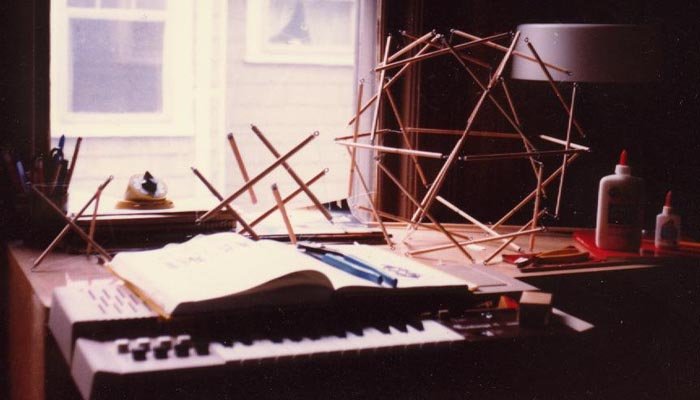

I was very faithful about building models when Hugh Kenner requested it in Geodesic Math, and learned a lot from doing so. Here are the first three. From left to right, a tensegrity prism (T-prism for short -- from p. 6), the T-icosahedron (from p. 11) and the T-icosidodecahedron (Fig. 3.4b on p. 21 but with the V-shaped slings for tendons suggested on p. 25).
I don't know who got me started using screw eyes. I can't find them mentioned in Kenner, Pugh (Introduction to Tensegrity, published as a companion book to Geodesic Math or at least at the same time in a very similar format) or the Grip handout (Tensegrity: Introductory Theory and Model Construction) Fuller's office sent me.
The T-icosahedron was a favorite demonstration piece. I remember showing it to at least one housemate and watching him push a couple struts toward each other and observe how all the struts contracted toward the center in unison. Layer I assembled the structure using very elastic rubber bands for struts and was surprised to find this property didn't hold. I could could press two struts fairly close to one another and the rest would stay out where they were. This was a rare experiment with elastic tendons, and for the most part I use inelastic ones. I think some people's experience is completely with elastic tendons and it gives them some weird ideas about tensegrity properties.
I later re-assembled the T-icosidodecahedron in the diamond configuration of Fig. 3.4b using monofilament fishing line. I see this was against Kenner's recommendation on p. 21 to "avoid monofilament nylon". I think he was right because that's the only time I've used it, and, as I remember, it was difficult to work with. It looked nice though.
I also remember assembling the T-cuboctahedron of Fig. 3.4b and being impressed with its graceful appearance. Neither that model or a photograph have survived. All these early explorations were in 1981 or 1982 sometime.


